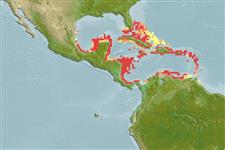Common names from other countries
Environment: milieu / climate zone / depth range / distribution range
Ecologia
Associadas(os) a recifes; intervalo de profundidade 1 - 30 m (Ref. 116012). Tropical; 28°N - 9°N, 98°W - 60°W (Ref. 846)
Western Atlantic.
Length at first maturity / Tamanho / Peso / Idade
Maturity: Lm ? range ? - ? cm
Colonies are branching with compact, horizontally spread sub-branches occurring towards the extremities of main branches. Axial corallites are elongate while radial corallites are tubular and irregular in length. Color can either be tan or pale brown with white branch tips.
Zooxanthellate (Ref. 116012). Very shallow reef slopes and lagoon margins (Ref. 846).
Life cycle and mating behavior
Maturidade | Reprodução | Desova | Ovos | Fecundidade | Larvas
Members of the class Anthozoa are either gonochoric or hermaphroditic. Mature gametes are shed into the coelenteron and spawned through the mouth. Life cycle: The zygote develops into a planktonic planula larva. Metamorphosis begins with early morphogenesis of tentacles, septa and pharynx before larval settlement on the aboral end.
Wallace, C.C. 1999. (Ref. 86439)
Status na Lista Vermelha da IUCN (Ref. 130435)
Status no CITES (Ref. 108899)
Not Evaluated
Uso pelos humanos
| FishSource |
Ferramentas
Mais informação
Idade/TamanhoCrescimentoComprimento-pesoComprimento-comprimentoMorfologiaLarvasAbundância
Fontes da internet
Estimates based on models
Preferred temperature
(Ref.
115969): 26.5 - 28.2, mean 27.4 (based on 333 cells).
Categoria de preço
Unknown.
